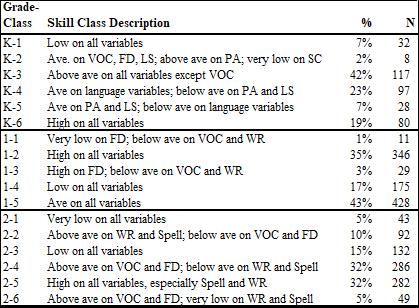Latent Profiles of Reading and Language and Their Association with Standardized Reading Outcomes in K-10th Grade
Barbara R Foorman, Yaacov Petscher, Christopher Stanley, & Adrea Truckenmiller
Differentiated instruction involves tailoring instruction to individual student’s learning needs. While critical to effective teaching, an understudied first step in differentiated instruction is understanding students’ learning profiles – that is, their strengths and weaknesses in knowledge and skills. It is only after a student’s learning profile is understood that a teacher can individualize instruction. But how can educators best measure learning profiles to facilitate differentiated instruction?
Descriptive approaches such as informal reading inventories lack the psychometric rigor required for purposes of classification, placement, and monitoring growth. However, quantitative approaches to classifying and clustering (i.e., grouping) students by skill classes and validating the clusters by relating them to standardized tests is a reliable tool for creating profiles. The objective of this study was twofold. First, to determine the profiles of reading and language skills that characterized 7,752 students in kindergarten through 10th grade. Second, to relate the profiles to standardized reading outcomes.
How did we do this study? Reading and language skills were assessed with a computer-adaptive assessment administered mid-year. Three measures of reading comprehension were administered in 3rd through 10th grades to create a latent variable (i.e., a variable that wasn’t directly observed, but represents a construct, such as reading comprehension). Latent profile analysis (LPA) was conducted on the reading and language measures to compute the probability of students clustering together based on the similarity of their scores.
What did we find? LPA results revealed five to six profiles in the elementary grades and three in the secondary grades that were strongly related to standardized reading outcomes. The profiles in the secondary grades followed a high, medium, and low pattern and indicated the need for intervention that targets word recognition and the academic language skills of vocabulary and text discourse. Profiles in the primary grades revealed variable patterns, with academic language strengths not necessarily compensating for weak alphabetic skills (see table below). Strategies for differentiating instruction in the elementary grades need to address students’ academic language needs and word identification skills.
Profiles of reading and language variables for K-2 students
Note: % (N) = percentage and number of students. The abbreviations for the K-2 FRA are: VOC = Vocabulary Pairs; FD = Following Directions; PA = Phonological Awareness; LS = Letter Sounds; SC = Sentence Comprehension; WR = Word Reading; Spell = Spelling.
Full Article Citation:
Foorman, B.R., Petscher, Y., Stanley, C. & Truckenmiller, A. (2017). Latent Profiles of Reading and Language and Their Association with Standardized reading Outcomes in Kindergarten Through Tenth Grade. Journal of Research on Educational Effectiveness, 10(3), 619-645. DOI: 10.1080/19345747.2016.1237597
